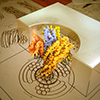| Oct 26, 2023 |
|
(Nanowerk News) A collaborative team of researchers led by prof. Cees Dekker at TU Delft, in partnership with international colleagues, introduces a pioneering breakthrough in the world of nanomotors – the DNA origami nanoturbine. This nanoscale device could represent a paradigm shift, harnessing power from ion gradients or electrical potential across a solid-state nanopore to drive the turbine into mechanical rotations.
|
Key Takeaways
|
|
A 25-nanometer DNA nanoturbine, driven by water flow, spins up to 20 revolutions per second.
Ion-sensitive rotation offers unique applications like targeted drug delivery.
DNA origami techniques provide full design control, advancing future energy-harnessing nanomachines.
Ingenious dual chiral turbines allow researchers to dictate rotation direction, enhancing control and functionality.
|
 |
| DNA origami nanoturbine sets new horizon for nanomotors. (Image: Cees Dekker Lab / SciXel)
|
The Research
|
|
The team’s research findings have been published in Nature Nanotechnology (“A DNA turbine powered by a transmembrane potential across a nanopore”).
|
|
Flow-driven turbines lie at the heart of many revolutionary machines that have shaped our societies, from windmills to airplanes. Even life itself depends critically on turbines for fundamental processes, such as the FoF1-ATP synthase that produces fuels for biological cells and the bacterial flagella motor that propels bacteria.
|
|
“Our nanoturbine has a 25-nanometer diameter rotor made from DNA material with blades configured in a right-handed or left-handed sense to control the direction of rotation. To operate, this structure is docked in a strong water flow, controlled by an electric field or salt concentration difference, from a nanopore, a tiny opening, in a thin membrane. We used our turbine to drive a rigid rod up to 20 revolutions per second”, says first author Dr. Xin Shi.
|
A fascinating revelation
|
|
One of the most intriguing discoveries of this research is the unique nature of the DNA origami nano-turbine’s rotation. Its behaviour is influenced by ion concentration, allowing the same turbine to spin either clockwise or anticlockwise, depending on the concentration of Na+ ions in the solution. This unique feature, exclusive to the nanoscale realm, results from the intricate interplay between ions, water, and DNA.
|
|
These findings, rigorously supported by extensive molecular dynamics simulations by the group of Aleksei Aksimentiev at University of Illinois and theoretical modelling by Ramin Golestanian at MPI Göttingen, hold the promise of expanding the horizons of nanotechnology, and offer numerous applications. For example, in the future, we might be able to use DNA-origami to make nanomachines that can deliver drugs into the human body, to specific types of cells.
|
DNA origami
|
|
Cees Dekker, who supervised the research, sheds light on their methodology: “Together with our collaborators at Hendrik Dietz’s lab from the Technical University of Munich, we used insights from our previous work on DNA rotary motors to now create a turbine with full control over its design and operation”.
|
|
The ‘DNA origami’ technique uses the specific interactions between complementary DNA base pairs to build dynamic 3D nano-objects. This design allows the direction of rotation of the turbine in our nanopores to be controlled through the handedness of the blades and allows straightforward integration of the turbine to other nanomachines.
|
A new step towards active transmembrane nanomachines
|
|
This research achievement follows last year’s introduction of the DNA active nanorotor, a self-configuring device capable of transforming energy from electrical or salt gradients into practical mechanical work. Read more: TU Delft researchers create flow-driven rotors at the nanoscale.
|
|
Reflecting on the remarkable journey, Xin Shi underscores the significance of their progress: “We’ve unveiled the fundamental principles behind propelling a nanoscale rotor using water and salt in nanopores. This year’s breakthrough, driven by rational design, marks the next phase of our journey. The foundational principles from our previous paper, combined with the innovations in this one, set the stage for the future of biomimetic transmembrane machines, with the potential to harness energy from salt gradients, a vital energy source employed by biological motors.”
|


